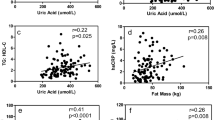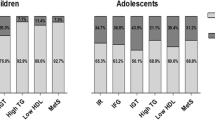Abstract
Background
Numerous studies have demonstrated that elevated serum uric acid concentration (SUA) is correlated with lipid profile in hypertensive or obese patients. However, the relationship between serum uric acid levels and lipid profile in non-obese late adolescent population was not examined before.
Aims
In this study we decided to assess the potential relationship between SUA and lipid profile, according to gender in adolescents with HU.
Methods
The study group comprises 607 Polish adolescents (474 males, 133 females) with HU. Retrospective analysis included demographic, clinical, and laboratory data. Lipid profile was assessed including total cholesterol (TC), low-density lipoprotein cholesterol (LDL-C), high-density lipoprotein cholesterol (HDL-C), triglycerides (TG), total cholesterol to HDL-C ratio (TC/HDL-C).
Results
In the examined group 187/607 (31 %) of teenagers were diagnosed with metabolic syndrome (MetS). Median BMI-Z-score was 1.11 Q1–Q3: (−0.02–2.03) and both females and males in the upper tertile of SUA had statistically significant higher BMI-Z-score. The males in the upper tertile of serum uric acid levels also had higher values of TG and lower of HDL-C. In females, we have not found significant differences in lipid profile. Multiple regression analyses indicated that male gender, BMI-Z-score, and presence of hypertension correlated significantly with serum uric acid concentration.
Conclusions
In summary, the results of our study confirm higher prevalence of hyperuricemia in males when compared to females and a stronger association of HU with BMI-Z-score and lipid profile in male adolescents. Nevertheless, multiple regression does not confirm the independent association of SUA with lipid profile.
Similar content being viewed by others
References
Cannon PJ, Stason WB, Demartini FE et al (1966) Hyperuricemia in primary and renal hypertension. N Engl J Med 275:457–464. doi:10.1056/NEJM196609012750902
Sui X, Church TS, Meriwether RA et al (2008) Uric acid and the development of metabolic syndrome in women and men. Metabolism 57:845–852. doi:10.1016/j.metabol.2008.01.030
Grayson PC, Kim SY, LaValley M, Choi HK (2010) Hyperuricemia and incident hypertension: a systematic review and meta-analysis. Arthritis Care Res (Hoboken) 63:102–110. doi:10.1002/acr.20344
Noone DG, Marks SD (2013) Hyperuricemia is associated with hypertension, obesity, and albuminuria in children with chronic kidney disease. J Pediatr 162:128–132. doi:10.1016/j.jpeds.2012.06.008
Rho YH, Zhu Y, Choi HK (2011) The epidemiology of uric acid and fructose. Semin Nephrol 31:410–419. doi:10.1016/j.semnephrol.2011.08.004
Edwards NL (2009) The role of hyperuricemia in vascular disorders. Curr Opin Rheumatol 21:132–137. doi:10.1097/BOR.0b013e3283257b96
Chuang S-Y, Lee S-C, Hsieh Y-T, Pan W-H (2011) Trends in hyperuricemia and gout prevalence: nutrition and health survey in Taiwan from 1993–1996 to 2005–2008. Asia Pac J Clin Nutr 20:301–308
Zhu Y, Pandya BJ, Choi HK (2011) Prevalence of gout and hyperuricemia in the US general population: the National Health and Nutrition Examination Survey 2007–2008. Arthritis Rheum 63:3136–3141. doi:10.1002/art.30520
Gresser UU, Gathof BB, Zöllner NN (1990) Uric acid levels in southern Germany in 1989. A comparison with studies from 1962, 1971, and 1984. Klin Wochenschr 68:1222–1228
Ruggiero C, Cherubini A, Ble A et al (2006) Uric acid and inflammatory markers. Eur Heart J 27:1174–1181. doi:10.1093/eurheartj/ehi879
Kostka-Jeziorny K, Tykarski A (2007) Wpływ terapii hipotensyjnej na stężenie kwasu moczowego. Nadciśnienie tętnicze
Feig DI (2003) Hyperuricemia in childhood primary hypertension. Hypertension 42:247–252. doi:10.1161/01.HYP.0000085858.66548.59
Baldwin WW, McRae SS, Marek GG et al (2011) Hyperuricemia as a mediator of the proinflammatory endocrine imbalance in the adipose tissue in a murine model of the metabolic syndrome. Diabetes 60:1258–1269. doi:10.2337/db10-0916
Zavaroni II, Mazza SS, Fantuzzi MM et al (1993) Changes in insulin and lipid metabolism in males with asymptomatic hyperuricemia. J Intern Med 234:25–30
Tsouli SGS, Liberopoulos ENE, Mikhailidis DPD et al (2006) Elevated serum uric acid levels in metabolic syndrome: an active component or an innocent bystander? Metab Clin Exp 55:1293–1301. doi:10.1016/j.metabol.2006.05.013
Feig DI, Kang D-H, Johnson RJ (2008) Uric acid and cardiovascular risk. N Engl J Med 359:1811–1821. doi:10.1056/NEJMra0800885
Tai ESE, Emmanuel SCS, Chew SKS et al (1999) Isolated low HDL cholesterol: an insulin-resistant state only in the presence of fasting hypertriglyceridemia. Diabetes 48:1088–1092
Chen L-Y, Zhu W-H, Chen Z-W et al (2007) Relationship between hyperuricemia and metabolic syndrome. J Zhejiang Univ Sci B 8:593–598. doi:10.1631/jzus.2007.B0593
Lippi G, Montagnana M, Luca Salvagno G et al (2009) Epidemiological association between uric acid concentration in plasma, lipoprotein(a), and the traditional lipid profile. Clin Cardiol 33:E76–E80. doi:10.1002/clc.20511
Sayin E, Sayin B, Ertugrul DT et al (2013) Is there a link between hyperuricemia, morning blood pressure surge, and non-dipping blood pressure pattern in metabolic syndrome patients? IJNRD 6:71–77. doi:10.2147/IJNRD.S41384
Sarmah D, Sharma B (2013) A correlative study of uric acid with lipid profile. Asian J Med Sci 4:8–14
Ishiro M, Takaya R, Mori Y et al (2013) Association of uric acid with obesity and endothelial dysfunction in children and early adolescents. Ann Nutr Metab 62:169–176. doi:10.1159/000346227
Pacifico L, Cantisani V, Anania C et al (2009) Serum uric acid and its association with metabolic syndrome and carotid atherosclerosis in obese children. Eur J Endocrinol 160(1):45–52. doi:10.1530/EJE-08-0618
Cole TJ, Flegal KM, Nicholls D, Jackson AA (2007) Body mass index cut offs to define thinness in children and adolescents: international survey. BMJ 335:194. doi:10.1136/bmj.39238.399444.55
Kułaga Z, Litwin M, Tkaczyk M et al (2010) Polish 2010 growth references for school-aged children and adolescents. Eur J Pediatr 170:599–609. doi:10.1007/s00431-010-1329-x
Cook SS, Weitzman MM, Auinger PP et al (2003) Prevalence of a metabolic syndrome phenotype in adolescents: findings from the third National Health and Nutrition Examination Survey, 1988–1994. Arch Pediatr Adolesc Med 157:821–827. doi:10.1001/archpedi.157.8.821
Lurbe E, Cífková R, Cruickshank JK et al (2009) Management of high blood pressure in children and adolescents: recommendations of the European Society of Hypertension. J Hypertens 27:1719–1742. doi:10.1097/HJH.0b013e32832f4f6b
Cole TJ, Bellizzi MC, Flegal KM, Dietz WH (2000) Establishing a standard definition for child overweight and obesity worldwide: international survey. BMJ 320:1240–1243
Friedewald WTW, Levy RIR, Fredrickson DSD (1972) Estimation of the concentration of low-density lipoprotein cholesterol in plasma, without use of the preparative ultracentrifuge. Clin Chem 18:499–502
Schwartz GJ, Furth SL (2007) Glomerular filtration rate measurement and estimation in chronic kidney disease. Pediatr Nephrol 22:1839–1848. doi:10.1007/s00467-006-0358-1
Yang J, Liu Z, Zhang C et al (2013) The prevalence of hyperuricemia and its correlates in an inland Chinese adult population, urban and rural of Jinan. Rheumatol Int 33:1511–1517. doi:10.1007/s00296-012-2589-8
Kubota M, Tang L, Nagai A et al (2010) Hyperuricemia in obese children and adolescents: the relationship with metabolic syndrome. Pediatr Rep. doi:10.4081/pr.2010.e12
Perea-Martinez A, Carbajal RL, Rodriguez HR et al (2008) Association of comorbidity with obesity in Mexican children and adolescents. Pediatrics 121:S149–S150. doi:10.1542/peds.2007-2022HHHHHH
Lu JJ-Y, Jiang DD-S, Chou S-M et al (2008) Prevalence of obesity and its association with cardiovascular disease risk factors in adolescent girls from a college in central Taiwan. Kaohsiung J Med Sci 24:144–151. doi:10.1016/S1607-551X(08)70142-6
Wang T, Liu G, Zheng R et al (2009) Serum uric acid and its correlation with cardiovascular risk factors in children with metabolic syndrome. J Clin Pediatr 12:008
Alper ABA, Alper AB, Chen WW et al (2004) Childhood uric acid predicts adult blood pressure: the Bogalusa Heart Study. Hypertension 45:34–38. doi:10.1161/01.HYP.0000150783.79172.bb
Jones DP, Richey PA, Alpert BS, Li R (2008) Serum uric acid and ambulatory blood pressure in children with primary hypertension. Pediatr Res 64:556–561. doi:10.1203/PDR.0b013e318183fd7c
Pereira MA, JACOBS DR, Van Horn L et al (2002) Dairy consumption, obesity, and the insulin resistance syndrome in young adults: the CARDIA study. JAMA 287:2081–2089. doi:10.1001/jama.287.16.2081
Agamah ESE, Webber LSL, Lawrence MM et al (1990) Serum creatinine and its relation to cardiovascular disease risk variables in children and young adults from a biracial community. The Bogalusa Heart Study. J Lab Clin Med 116:327–334
Rathmann W, Funkhouser E, Dyer AR, Roseman JM (1998) Relations of hyperuricemia with the various components of the insulin resistance syndrome in young black and white adults: the CARDIA study. Ann Epidemiol 8:250–261. doi:10.1016/S1047-2797(97)00204-4
Takahashi S, Yamamoto T, Moriwaki Y et al (1995) Increased concentrations of serum Lp(a) lipoprotein in patients with primary gout. Ann Rheum Dis 54:90–93
Ford ES, Li C, Cook S, Choi HK (2007) Serum concentrations of uric acid and the metabolic syndrome among US children and adolescents. Circulation 115:2526–2532. doi:10.1161/CIRCULATIONAHA.106.657627
Wang J-Y, Chen Y-L, Hsu C-H et al (2012) Predictive value of serum uric acid levels for the diagnosis of metabolic syndrome in adolescents. J Pediatr 161:753–756. doi:10.1016/j.jpeds.2012.03.036
Todorova MK, Ramsheva ZN, Ramshev KN et al (2009) Serum lipids, uric acid and leptin/adiponectin ratio in clinically healthy normal weight and overweight young men, aged 17–20 years. J Mens health 6:63–69. doi:10.1016/j.jomh.2008.09.010
Conen D, Wietlisbach V, Bovet P et al (2004) Prevalence of hyperuricemia and relation of serum uric acid with cardiovascular risk factors in a developing country. BMC Public Health 4:9. doi:10.1186/1471-2458-4-9
Denzer C, Muche R, Mayer H et al (2003) Serum uric acid levels in obese children and adolescents: linkage to testosterone levels and pre-metabolic syndrome. J Pediatr Endocrinol Metab. doi:10.1515/JPEM.2003.16.9.1225
Dawson J, Walters M (2006) Uric acid and xanthine oxidase: future therapeutic targets in the prevention of cardiovascular disease? Br J Clin Pharmacol 62:633–644. doi:10.1111/j.1365-2125.2006.02785.x
Conflict of interest
None.
Author information
Authors and Affiliations
Corresponding author
Rights and permissions
About this article
Cite this article
Stelmach, M.J., Wasilewska, N., Wicklund-Liland, L.I. et al. Blood lipid profile and BMI-Z-score in adolescents with hyperuricemia. Ir J Med Sci 184, 463–468 (2015). https://doi.org/10.1007/s11845-014-1146-8
Received:
Accepted:
Published:
Issue Date:
DOI: https://doi.org/10.1007/s11845-014-1146-8




